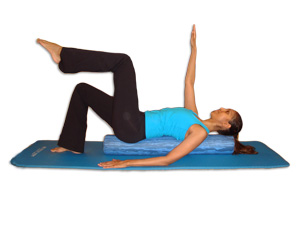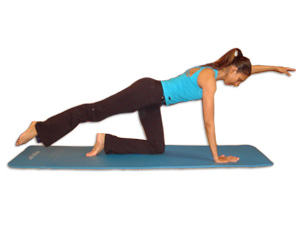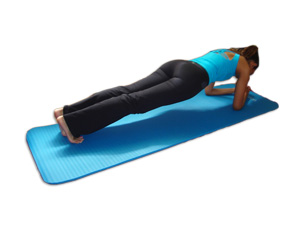pilates exercises
Favorite Exercises that Work
There is much literature on the core in today’s society, some of it good and some of it questionable. Because many of us spend so much time in flexion (seated at a desk, driving, watching TV etc), it does not behoove us to continue to overemphasize flexion in our workouts. In order to achieve spinal stability, some attention should be given to the deeper muscles of the body.
Here are a few of our favorite exercises that contribute to lumbopelvic stability and core strength.
Before attempting these exercises, make sure you consult a physician and are free from injuries to the back, neck and joints. Should you experience any pain in these regions, stop the activity and attend to your injury. Cultivate cognitive awareness of your breath, alignment, shoulder girdle and hip positioning. Sloppy and uncontrolled movements can lead to new injuries or exacerbate old injuries. Attempt to remain in neutral spine at all times. This simply means you need to maintain the natural curvature of the spine, as this is the optimal position for your spinal discs. Engage the anterior portion of your pelvic floor subtly (imagine you are stopping the flow of urine) and keep remembering to do so throughout the exercises. Do not clench at the glutes (buttocks) nor should you suck in your stomach with a fury. Think about gently drawing the abdominal wall towards the spine and then subtly narrowing the waist. The abdominal engagement should be consistent throughout the workout.
Lifting of the knee
- Lie on your back now. Spine is neutral. Pelvis is level. Shoulders are relaxed and the arms are by your sides. Face is calm. Body is tension free. Knees are bent; the soles of your feet should be touching the ground.
- Lift the right knee using the hip flexor and quadriceps muscle, keeping the knee bent, until your shin is in a table top position.
- Slowly bring the leg back down to its start position whilst controlling the landing of the foot. Land quietly.
- Repeat for the other side. Lift ten times for each side.
- Avoid excessive rocking of the pelvis. Continue to engage abdominals and pelvic floor throughout.
- To further challenge the core, you can do this exercise with your spine on a foam roller.

Bird-Dog
Our clients love this one!
- Come into an all fours position/quadruped and maintain neutral spine. Widen your shoulder blades; arms are straight but not locked.
- Keep the wrists under the shoulders and the knees under the hips.
- Gently contract the pelvic floor, followed by the abdominals.
- Start extending opposite arm and leg out.
- Do not hike the hip nor twist the spine. Poor form can lead to overuse of the global muscles, so be aware of how the body is moving.
- Attempt to hold each side for five to ten seconds and don’t forget to breath naturally. Do this for about five times each side.
- Rest in child’s pose, or any other restful position when done.

Elbow Plank
Oh, this is such a good one for the abdominals and you will feel it there, if your form and technique are good.
- Lie prone, with your arms by your sides and your elbows bent.
- Keep your legs straight and ankles in dorsiflexion.
- Gently engage the pelvic floor followed by the abdominals.
- Slowly push the upper body off the mat, positioning the bent elbows under the shoulders and the palms on the ground, underneath your face. You can clasp your hands if you want.
- Be aware of what your lower back is doing.
- Avoid looking like a banana; don’t arch your back and do not hike the hips to the sky-no downward dogs please. We love the downward dog, but that should be saved for yoga class.
- Make sure your shoulders are away from your ears and that you are not overly clenching your glutes (buttocks)!
- Hold this position whilst breathing normally for at least 20 to 30 seconds.











